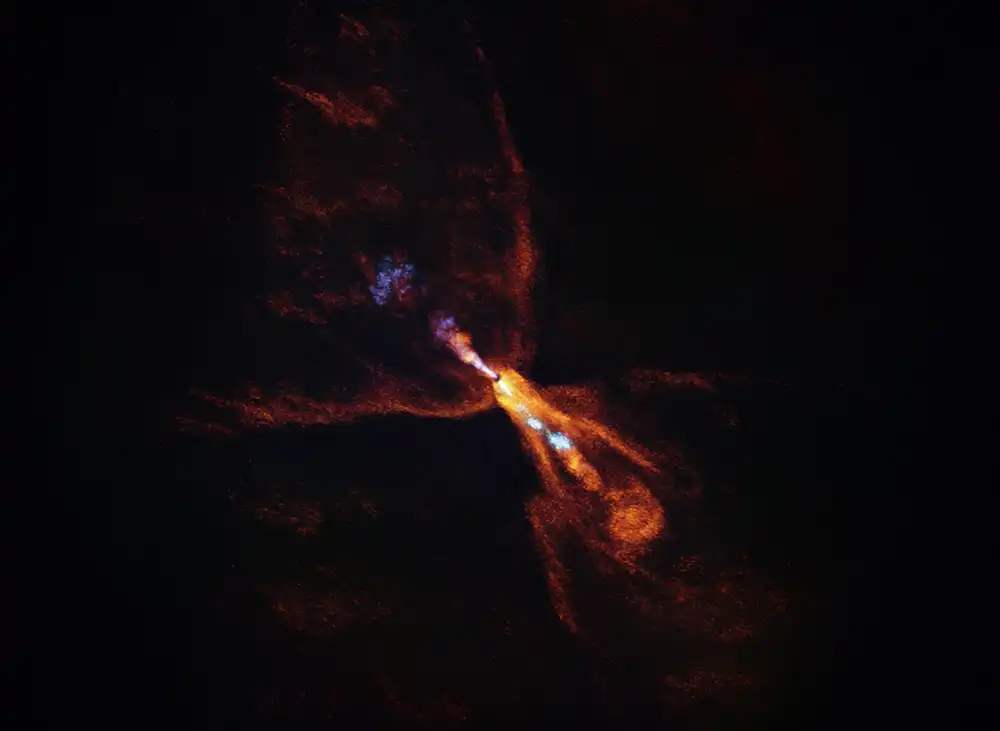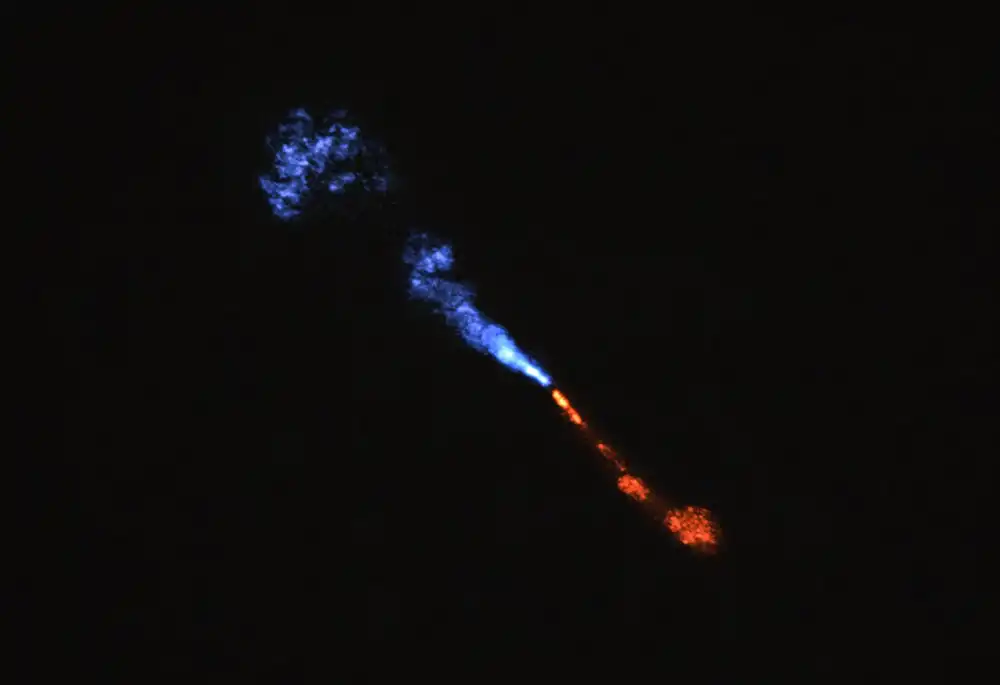PROTECT YOUR DNA WITH QUANTUM TECHNOLOGY
Orgo-Life the new way to the future Advertising by AdpathwayAstronomers have found a baby system that’s just beginning to build planets — and it can tell us about how and where planet formation starts.
 This is HOPS-315, a baby star where astronomers have observed evidence for the earliest stages of planet formation using data from the Atacama Large Millimeter/submillimeter Array (ALMA) and the James Webb Space Telescope (JWST). Orange highlights emissions from carbon monoxide molecules, which blow away from the star in a butterfly-shaped wind. A narrow jet of silicon monoxide is visible in blue. In addition to these features, there is also a disk of gaseous silicon monoxide around the star that is condensing into solid silicates –– the first stages of planetary formation.
This is HOPS-315, a baby star where astronomers have observed evidence for the earliest stages of planet formation using data from the Atacama Large Millimeter/submillimeter Array (ALMA) and the James Webb Space Telescope (JWST). Orange highlights emissions from carbon monoxide molecules, which blow away from the star in a butterfly-shaped wind. A narrow jet of silicon monoxide is visible in blue. In addition to these features, there is also a disk of gaseous silicon monoxide around the star that is condensing into solid silicates –– the first stages of planetary formation.ALMA (ESO /NAOJ / NRAO) / M. McClure et al.
The James Webb Space Telescope (JWST) has enabled many discoveries, from the most distant galaxies to new molecules in planetary atmospheres, and last week astronomers added another impressive first to its collection: a baby solar system. Located around 1,300 light-years away in the Orion Nebula, HOPS-315 is a protostar — a young star that has only recently emerged from its natal cloud of dust and gas.
A team led by Melissa McClure (Leiden Observatory, The Netherlands) observed the baby system with JWST and the Atacama Large Millimeter/submillimeter Array (ALMA), finding warm silicate monoxide (SiO) gas and solid grains rich in the same material. The detections are indicative of early planet formation, in which hot gas cools and condenses to form silicate minerals that will eventually make up rocky planets — a process that occurred in our own solar system some 4.5 billion years ago.
The system’s young age makes it a prime laboratory to study planet formation in the earliest stages of a star’s life, as HOPS-315 still has a million years to go before it reaches the heft of the Sun. “Our detections were consistent with the theory [of solar system formation] that says that these minerals need to condense close to the protostar, rather than farther out in the disk,” McClure says.
Silicon monoxide molecules glom onto grains in the HOPS-315 system.
ESO / L. Calçada / ALMA (ESO / NAOJ / NRAO) / M. McClure et al.
Building Planets
The team used JWST to take an infrared spectrum of HOPS-315. Different molecules absorb specific wavelengths based on their chemical properties, leaving dips (absoprtion lines) in the spectrum that astronomers can observe and characterize.
A previous spectrum of the system, taken by the Spitzer Space Telescope, revealed hints of hot rocky material but lacked the resolution to show the SiO gas, McClure says. The JWST observations, published in Nature, show that the absorption lines came from warm SiO gas and crystalline silicate grains close to the star. They also found that the disk’s midplane was more than 1200K (1,700°F), hot enough to vaporize silicate rocks. As the disk cools, that material settles into planet-forming grains.
 This image shows jets of silicon monoxide (SiO) blowing away from the baby star HOPS-315. The blue jet is moving towards us, and the red one is moving away. Observations taken with the James Webb Space Telescope (JWST) show signatures of SiO moving at about 10 km/s. The SiO jets seen in this ALMA image move about 10 times faster though. This means that the slow-moving SiO must be located in a small area around the star, about the size of the asteroid belt around our Sun, too small to be seen in this image. Also, the abundance of gaseous SiO measured in the jet seen with ALMA is lower than expected. Since the composition of the jet should be similar to that of the disc from where the jet emerges, this means that some of the gaseous SiO in the disc is condensing into solid material.
This image shows jets of silicon monoxide (SiO) blowing away from the baby star HOPS-315. The blue jet is moving towards us, and the red one is moving away. Observations taken with the James Webb Space Telescope (JWST) show signatures of SiO moving at about 10 km/s. The SiO jets seen in this ALMA image move about 10 times faster though. This means that the slow-moving SiO must be located in a small area around the star, about the size of the asteroid belt around our Sun, too small to be seen in this image. Also, the abundance of gaseous SiO measured in the jet seen with ALMA is lower than expected. Since the composition of the jet should be similar to that of the disc from where the jet emerges, this means that some of the gaseous SiO in the disc is condensing into solid material.ALMA (ESO /NAOJ / NRAO) / M. McClure et al.
HOPS-315 is also conveniently oriented so that the disk is visible through the jets spewing from the newborn star. Since the shape of absorption lines depends on how far away the absorbing material is from the star, the team was able to estimate that the silicon monoxide gas swirls close to the disk — around the distance that Earth orbits the Sun (1 astronomical unit, or au).
The team followed up with ALMA observations at millimeter wavelengths, detecting more silicon monoxide gas in the jets, 10 times farther out. The data confirm that the silicon monoxide gas in the disk lies closer to the star and isn't part of the jets.
Winding Back the Clock
HOPS-315, and its disk that’s 35 au wide, is a compelling analog to our own solar system. “The star is on track to grow to be as large as the Sun,” McClure says, “and the disk is about the same mass and radius . . . as the Sun’s disk at a similar age.”
The system may help settle debate about how and where terrestrial planets formed. They might have formed farther from the star, where water is cold enough to become ice, or closer in, where the silicon monoxide gas lives. The HOPS-315 observations confirm that these hot materials do condense from gas into rock closer in to the star.
“Our results . . . provide physical constraints on what the region around the sun within 1 au might have looked like for our solar system,” McClure says, “which will allow people to test these theories.”
At the same time, the team also detected less silicon- and iron-rich gas in the jets than they expected. That findig hints that planetary embryos have already begun taking up those materials.
 This chart shows the location of the nascent star HOPS-315 in the constellation Orion. This map shows most of the stars visible to the unaided eye under good conditions. The location of the star itself is marked with a red circle.
This chart shows the location of the nascent star HOPS-315 in the constellation Orion. This map shows most of the stars visible to the unaided eye under good conditions. The location of the star itself is marked with a red circle.ESO / IAU & Sky & Telescope
McClure hopes to continue studying the system to see where planets are starting to form. “We are also studying other protostars like HOPS-315 to understand whether this stage is really common to all protoplanetary disks,” McClure says. After all, our solar system doesn’t look like most exoplanet systems that we’ve found elsewhere in the Milky Way. Further study could also determine how long-lived this phase is around other stars.
For the first time, astronomers have captured a young star just beginning to assemble its planets. Future observations of HOPS-315 and other systems will continue to unfold that story.


 1 week ago
21
1 week ago
21





















 English (US) ·
English (US) ·  French (CA) ·
French (CA) ·